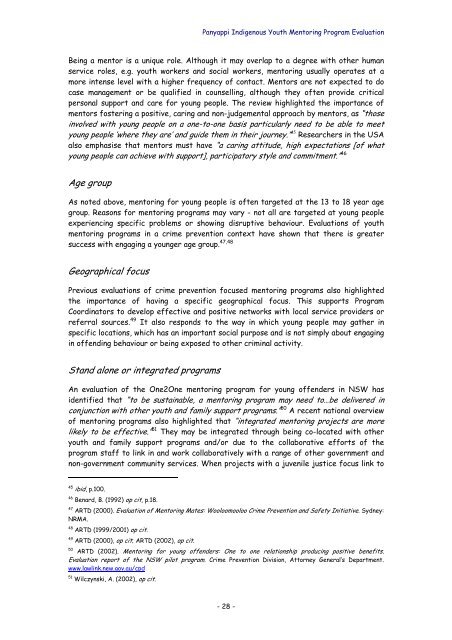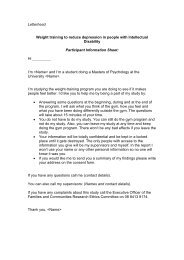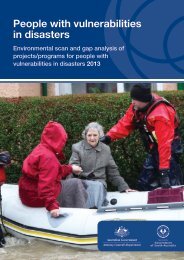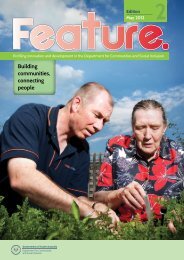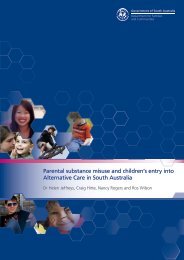Panyappi Indigenous Youth Mentoring Program Evaluation
Panyappi Indigenous Youth Mentoring Program Evaluation
Panyappi Indigenous Youth Mentoring Program Evaluation
You also want an ePaper? Increase the reach of your titles
YUMPU automatically turns print PDFs into web optimized ePapers that Google loves.
<strong>Panyappi</strong> <strong>Indigenous</strong> <strong>Youth</strong> <strong>Mentoring</strong> <strong>Program</strong> <strong>Evaluation</strong><br />
Being a mentor is a unique role. Although it may overlap to a degree with other human<br />
service roles, e.g. youth workers and social workers, mentoring usually operates at a<br />
more intense level with a higher frequency of contact. Mentors are not expected to do<br />
case management or be qualified in counselling, although they often provide critical<br />
personal support and care for young people. The review highlighted the importance of<br />
mentors fostering a positive, caring and non-judgemental approach by mentors, as “those<br />
involved with young people on a one-to-one basis particularly need to be abe l to meet<br />
young people ‘where they are’ and guide them in their journey. ” 45 Researchers in the USA<br />
also emphasise that mentors must have “a caring attitude, high expectations [of what<br />
young people can achieve with support], participatory style and commitment.” 46<br />
Age group<br />
As noted above, mentoring for young people is often targeted at the 13 to 18 year age<br />
group. Reasons for mentoring programs may vary - not all are targeted at young people<br />
experiencing specific problems or showing disruptive behaviour. <strong>Evaluation</strong>s of youth<br />
mentoring programs in a crime prevention context have shown that there is greater<br />
success with engaging a younger age group. 47,48<br />
Geographical focus<br />
Previous evaluations of crime prevention focused mentoring programs also highlighted<br />
the importance of having a specific geographical focus. This supports <strong>Program</strong><br />
Coordinators to develop effective and positive networks with local service providers or<br />
referral sources. 49 It also responds to the way in which young people may gather in<br />
specific locations, which has an important social purpose and is not simply about engaging<br />
in offending behaviour or being exposed to other criminal activity.<br />
Stand alone or integrated programs<br />
An evaluation of the One2One mentoring program for young offenders in NSW has<br />
identified that “to be sustainable, a mentoring program may need to…be delivered in<br />
conjunction with other youth and family support programs.” 50 A recent national overview<br />
of mentoring programs also highlighted that “integrated mentoring projects are more<br />
likely to be effective.” 51 They may be integrated through being co-located with other<br />
youth and family support programs and/or due to the collaborative efforts of the<br />
program staff to link in and work collaboratively with a range of other government and<br />
non-government community services. When projects with a juvenile justice focus link to<br />
45 ibid, p.100.<br />
46 Benard, B. (1992) op cit, p.18.<br />
47<br />
ARTD (2000). <strong>Evaluation</strong> of <strong>Mentoring</strong> Mates: Wooloomooloo Crime Prevention and Safety Initiative. Sydney:<br />
NRMA.<br />
48 ARTD (1999/2001) op cit.<br />
49<br />
ARTD (2000), op c t; i ARTD (2002), op cit.<br />
50<br />
ARTD (2002). <strong>Mentoring</strong> for young offenders: One to one relationship producing positive benefits.<br />
<strong>Evaluation</strong> report of the NSW pilot program. Crime Prevention Division, Attorney General’s Department.<br />
www.lawlink.new.gov.au/cpd<br />
51 Wilczynski, A. (2002), op cit.<br />
- 28 -


